Dolmen
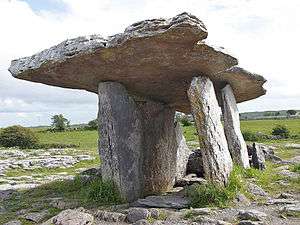
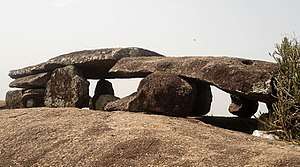
A dolmen (/ˈdɒlmɛn/) is a type of single-chamber megalithic tomb, usually consisting of two or more vertical megaliths supporting a large flat horizontal capstone or "table". Most date from the early Neolithic (4000–3000 BC) and were sometimes covered with earth or smaller stones to form a tumulus. Small pad-stones may be wedged between the cap and supporting stones to achieve a level appearance.[1] In many instances, the covering has weathered away, leaving only the stone "skeleton" of the mound intact.
It remains unclear when, why and by whom the earliest dolmens were made. The oldest known are found in Western Europe, dating from c 7,000 years ago. Archaeologists still do not know who erected these dolmens, which makes it difficult to know why they did it. They are generally all regarded as tombs or burial chambers, despite the absence of clear evidence for this. Human remains, sometimes accompanied by artefacts, have been found in or close to the dolmens which could be scientifically dated using radiocarbon dating. However, it has been impossible to prove that these remains date from the time when the stones were originally set in place.[2]
Etymology
The word dolmen has an unclear history. The word entered archaeology when Théophile Corret de la Tour d'Auvergne used it to describe megalithic tombs in his Origines gauloises (1796) using the spelling dolmin (the current spelling was introduced about a decade later and had become standard in French by about 1885).[3][4] The Oxford English Dictionary does not mention "dolmin" in English and gives its first citation for "dolmen" from a book on Brittany in 1859, describing the word as "The French term, used by some English authors, for a cromlech ...". The name was supposedly derived from a Breton language term meaning "stone table" but doubt has been cast on this, and the OED describes its origin as "Modern French". A book on Cornish antiquities from 1754 said that the current term in the Cornish language for a cromlech was tolmen ("hole of stone") and the OED says that "There is reason to think that this was the term inexactly reproduced by Latour d'Auvergne [sic] as dolmen, and misapplied by him and succeeding French archaeologists to the cromlech".[5] Nonetheless it has now replaced cromlech as the usual English term in archaeology, when the more technical and descriptive alternatives are not used.
Dolmens are known by a variety of names in other languages, including Irish: dolmain, Galician and Portuguese: anta, German: Hünengrab/Hünenbett, Afrikaans and Dutch: hunebed, Abkhazian: Adamra, Adyghe Ispun, dysse (Danish and Norwegian), dös (Swedish), Korean: 고인돌 goindol (mordenized word: stacked stone), "dol (stone)", "dolmaengi (pebble-stones, varied stones)", and Hebrew: גַלעֵד. Granja is used in Portugal, Galicia, and Spain. The rarer forms anta and ganda also appear. In the Basque Country, they are attributed to the jentilak, a race of giants.
The etymology of the German: Hünenbett, Hünengrab and Dutch: hunebed - with Hüne/hune meaning "giant" - all evoke the image of giants buried (bett/bed/grab = bed/grave)there. Of other Celtic languages, Welsh: cromlech was borrowed into English and quoit is commonly used in English in Cornwall.
Types
- A dolmen erected by Neolithic people in Marayur, Kerala, India.
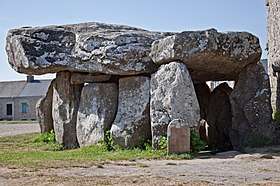 Crucuno dolmen in Plouharnel, Brittany, France
Crucuno dolmen in Plouharnel, Brittany, France Kilclooney More dolmen near Ardara, County Donegal, Ireland
Kilclooney More dolmen near Ardara, County Donegal, Ireland- Lancken-Granitz dolmen, Germany
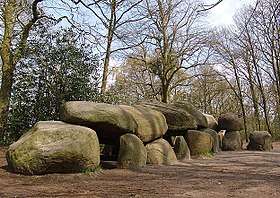 T-shaped Hunebed D27 in Borger-Odoorn, Netherlands
T-shaped Hunebed D27 in Borger-Odoorn, Netherlands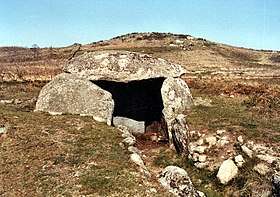 Dólmen da Aboboreira, Baião, Portugal
Dólmen da Aboboreira, Baião, Portugal- Dolmen of Avola, Sicily
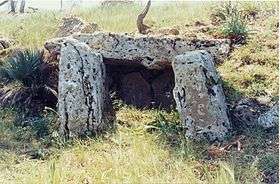 Dolmen of Monte Bubbonia, Sicily
Dolmen of Monte Bubbonia, Sicily.jpg) Dolmen of Cava dei Servi, Sicily
Dolmen of Cava dei Servi, Sicily Dolmen of Oleiros, Galicia
Dolmen of Oleiros, Galicia Dolmen Sa Coveccada, Mores, Sardinia
Dolmen Sa Coveccada, Mores, Sardinia
See also
References
- ↑ Murphy (1997), 43
- ↑ Lewis, S. (2009) Guide to the Menhirs and other Megaliths of Central Brittany, Nezert Books, ISBN 978-952-270-595-2
- ↑ Bakker, Jan Albert (2009). Megalithic Research in the Netherlands, 1547–1911. Sidestone Press. p. 36. ISBN 978-9088900341.
- ↑ Corret de la Tour d'Auvergne, Origines gauloises. Celles des plus anciens peuples de l'Europe puisées dans leur vraie source ou recherche sur la langue, l'origine et les antiquités des Celto-bretons de l'Armorique, pour servir à l'histoire ancienne et moderne de ce peuple et à celle des Français, p. PR1, at Google Books, 1796–97.
- ↑ OED "Dolmen", 1st edition, 1897
Sources
- Holcombe, Charles (2011). A History of East Asia: From the Origins of Civilization to the Twenty-First Century. Cambridge University Press. ISBN 978-0-521-51595-5.
- Piccolo, Salvatore (2013). Ancient Stones: The Prehistoric Dolmens of Sicily. Thornham/Norfolk: Brazen Head Publishing. ISBN 978-0-9565106-2-4.
- Murphy, Cornelius. The Prehistoric Archaeology of the Beara Peninsula, Co. Cork. Department of Archaeology, University College Cork, 1997
Further reading
- Trifonov, V., 2006. Russia's megaliths: unearthing the lost prehistoric tombs of Caucasian warlords in the Zhane valley. St.Petersburg: The Institute for Study of Material Culture History, Russian Academy of Sciences. Available from
- Kudin, M., 2001. Dolmeni i ritual. Dolmen Path – Russian Megaliths. Available from
- Knight, Peter. Ancient Stones of Dorset, 1996.
External links
| Wikimedia Commons has media related to Dolmen. |
| Look up dolmen in Wiktionary, the free dictionary. |
- World heritage site of dolmen in Korea
- Piccolo, Salvatore. "Dolmen." Ancient History Encyclopedia.
- The Megalithic Portal and Megalith Map
- Dolmen Museum in Italian and English
- Goindol: Dolmen of Korea
- Research Centre of Dolmens in Northeast Asia
- Poulnabrone Dolmen in the Burren, County Clare, Ireland
- "Dolmen (Goindol) sites in Korea". on UNESCO's World Heritage List.
- Jersey Heritage Trust
- Dolmen Pictures by Robert Triest.